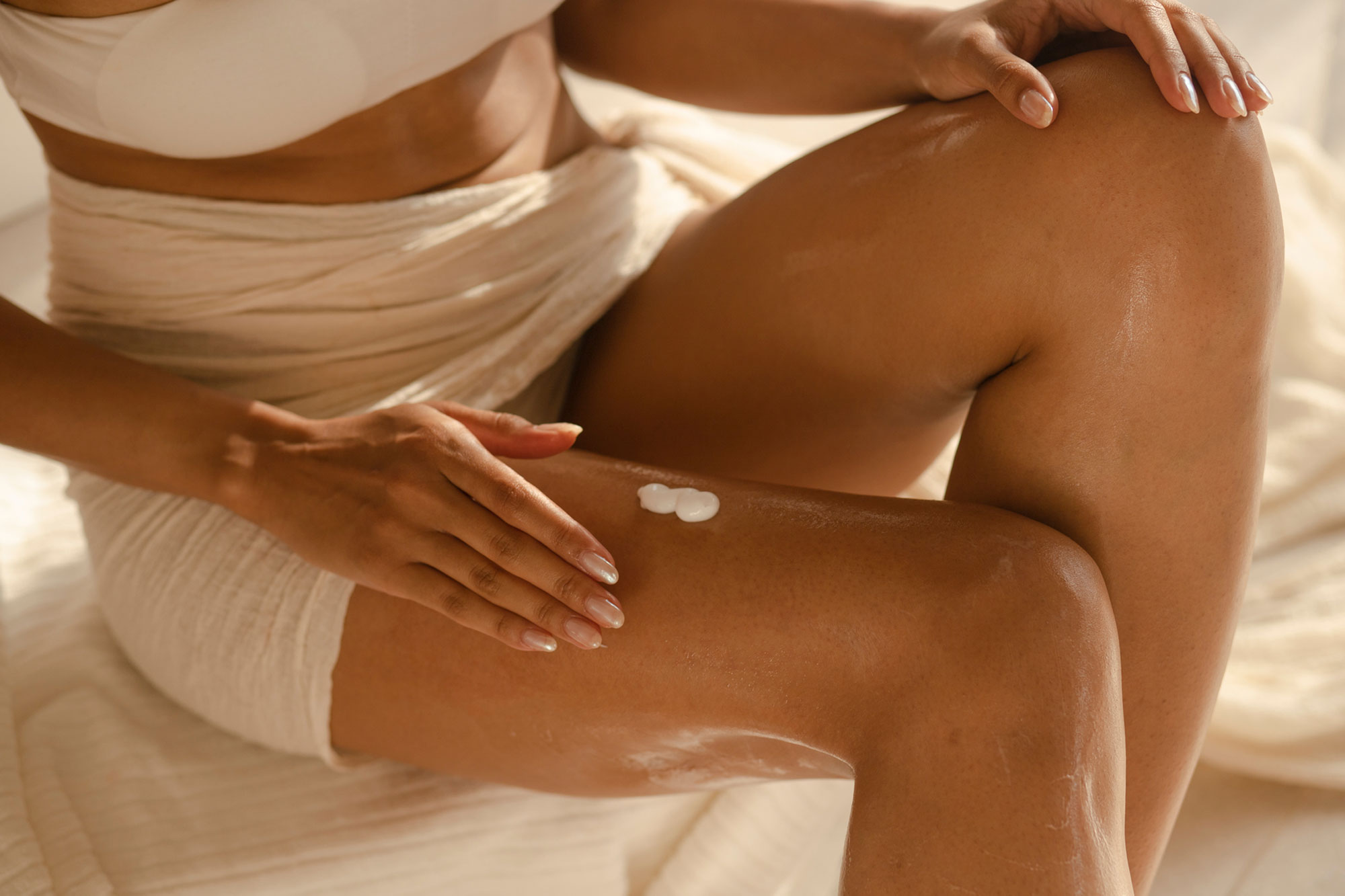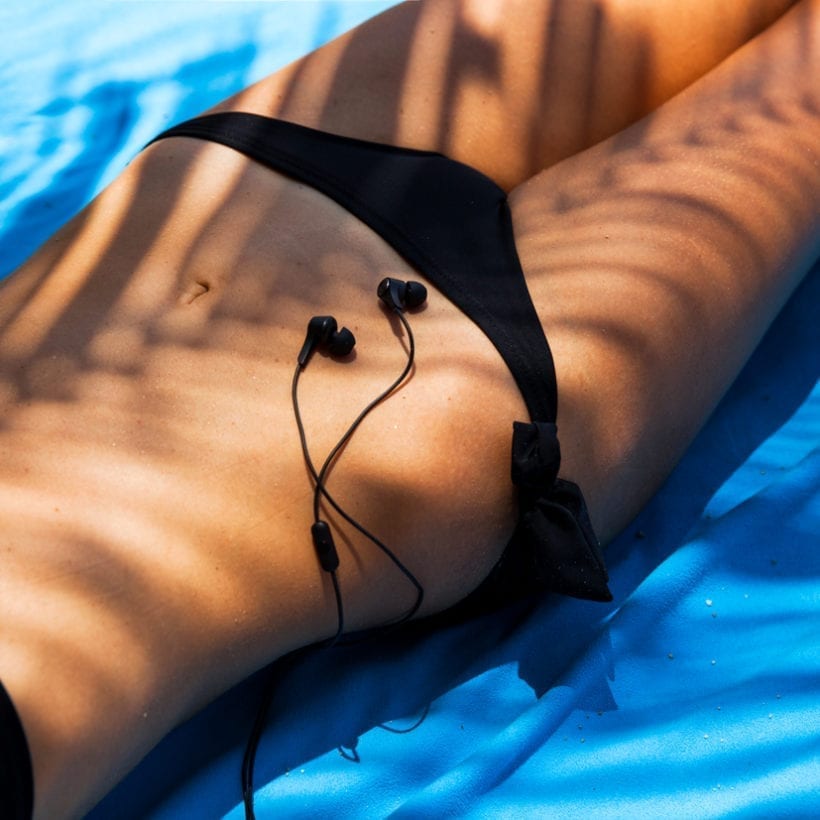We love a gorgeous golden glow, but any derm will tell ya, the best tan is a fake tan. Soaking in the sun can cause damage, but thankfully, self-tanner can give you those just-got-back-from-vacay vibes way more safely — and year-round. If you’ve ever found yourself spotting streaks though, you’re not the only one. It’s all about your technique. Below, Sophie Evans dives into some of the most common mistakes you can avoid, so you’re always streak-free.
Meet the Experts
Sophie Evans is a St. Tropez Skin Finishing Expert.
You’re not exfoliating
It’s all about the prep. First, use a body scrub to slough off dead skin cells and create a smooth surface for your self-tanner to adhere to. Otherwise, you can be left with a patchy finish. Try Sunday Riley Charcoal Smoothie Jelly Body Scrub — the mix of salicylic acid, biodegradable waxes, and activated charcoal physically and chemically exfoliate the skin, so it’s extra smooth. In addition to giving your self-tanner a more even look, it can also help your tan to last longer.
You forgot to moisturize beforehand

Before applying self-tanner, you want to apply a water-based moisturizer to extra absorbent areas, like elbows, hands, feet, and heels. “The skin in these areas absorb more easily, so applying moisturizer mitigates that; it helps act like a barrier,” says Evans. Then, to make your self-tan look flawless, blend a little moisturizer with your self-tanner to help fade the tan down from the wrist and heels. “This helps your tan look seamless,” notes Evans.
You’re applying self-tanner with your hands
You wouldn’t frost a cake with your hands, right? Similarly, to get that even finish with self-tanner, you need the right tool. Using a hand mitt (like the St.Tropez Double-Sided Luxe Velvet Applicator Mitt) helps the self-tanner go on more uniformly whereas fingers can leave tell-tale streaks. Also, this will prevent your palms from getting stained. “The mitts protect hands, but you’ll also use less product, and it’ll go on smoother with the mitt,” Evans explains. The mitt also can cover a large area at a time, so application is more seamless.
You didn’t spot test
While technique is key, the formula you choose also determines how flawless your self-tan will look. Each formula contains a different amount of DHA (dihydroxyacetone), a sugar that interacts with the dead skin cells in the outer layer of the epidermis and, in turn, deepens your skin tone. Most self-tanning foams and lotions may contain between 3-5% DHA1, but darker formulations contain a higher concentration. Choosing a too-deep shade, if you’re fair, might cause the skin to look muddy or orange. Since you might not know the concentration in your self-tanner, spot-test new formulas in an inconspicuous area like your wrist to see how the formula works on your skin. And remember, it can take up to 8 hours for the color to fully develop.

You’re not applying enough product
Evans tells us this is usually the biggest mistake she sees. “It’s the lack of product that causes streaks. You’re trying to cover too much area with too little product, and that back and forth action can cause streaks,” says she. Apply two pumps per limb and use your mitt in a sweeping motion to fully cover the surface. We love a mousse that easily glides over the skin like St. Tropez Self-Tan Luxe Whipped Crème Mousse; this silky whip is infused with hyaluronic acid, vitamin E, and niacinamide, plus it has no tell-tale smell of DHA. On that note: If you’re using a facial self-tanner, don’t forget to extend it to your neck and décolletage, so it’s not a dead giveaway that you’re using a faux tan. And, when you’re using tanner on your body, get your armpits, back of your knees, and other areas that might not immediately come to mind.
… But you’re overapplying on hands and feet
Even self-tanner regulars might struggle with a few areas, namely hands and feet. These areas can often look splotchy. Due in part to the fact that “these areas tend to tan easily, says Evans, so you want to apply sparingly. “Use whatever is leftover from application, that little bit of excess product after doing your other limbs.“ You don’t need much in these spots.
You shower or sweat too soon after application
While each self-tanner is different, many formulations take up to eight hours to fully develop. That means you might be cutting the development process if you shower, swim, or sweat heavily during a workout before that eight-hour mark. For example, sweat might make your finish patchy, while a swim or a shower completely halts the process. Instead, try to throw on a park of dark sweatpants and enjoy low-key activities. Once a fellow editor told us she has self-tanner bedsheets. She would apply self-tanner a couple of hours before bedtime and sleep on cheap dark sheets that she wouldn’t mind getting stained. We can’t help but agree that self-tanning while sleeping is multitasking at its finest.
You’re not hydrating post-application
Yes, you may have aced the self-tanner application, but to keep it look fresh and its best, don’t forget to keep skin hydrated. Making sure you’re moisturizing daily will keep your self-tan lasting longer and also allow it to look more vibrant. Your best bet? Try Fairy Godmother Shimmering Body Oil Gel. This silky oil, infused with vitamin C and CoQ10, instantly hydrates and leaves a soft golden shimmer to boost that faux glow.
We only recommend products we have independently researched, tested, and loved. If you purchase a product found through our links, Sunday Edit may earn an affiliate commission.









